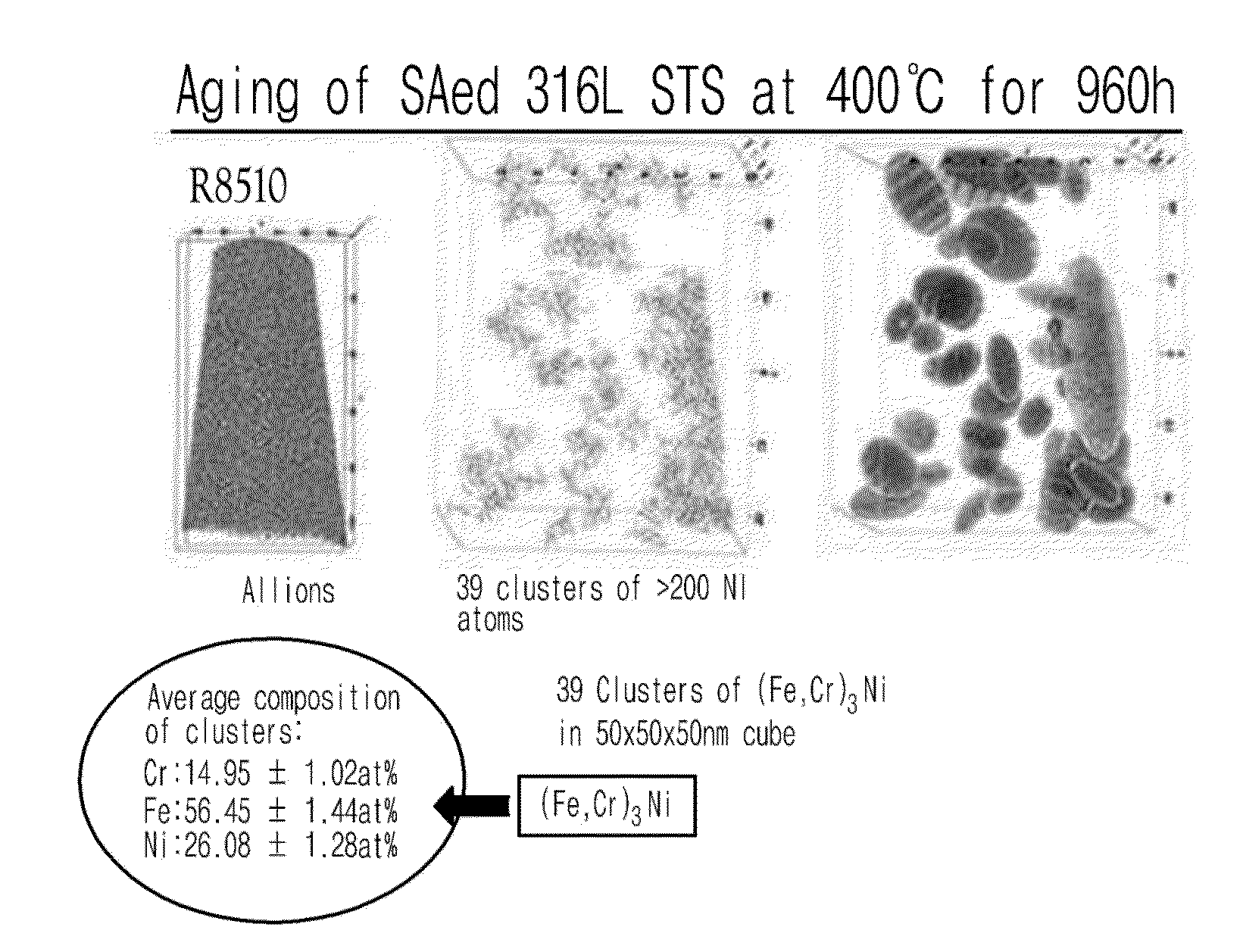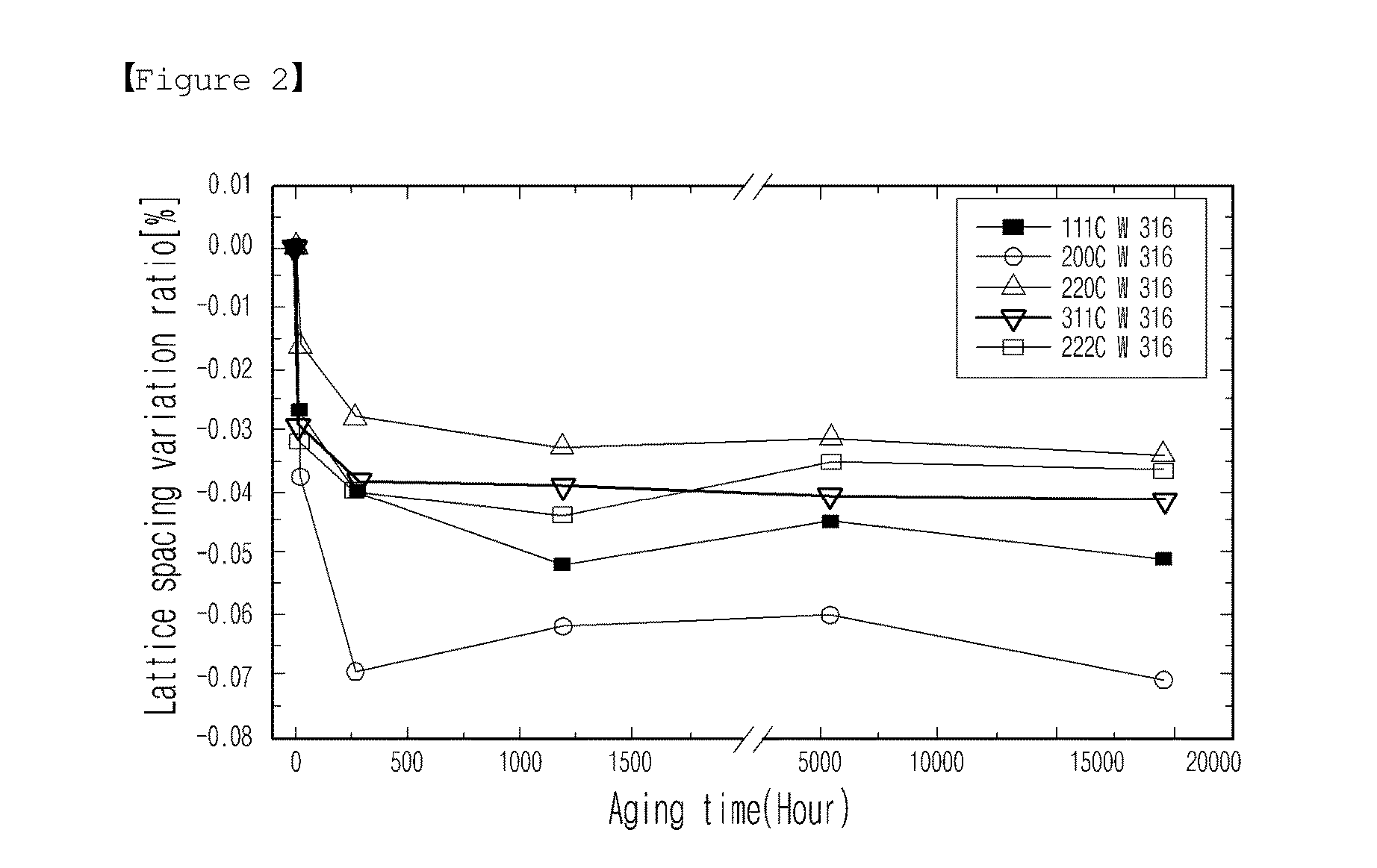Method of non-destructive evaluation of intergranular stress corrosion cracking (IGSSC) in structural components made of metal alloys, and the method of lifetime evaluation of the structural components
a technology of intergranular stress corrosion and structural components, which is applied in the direction of nuclear elements, instruments, greenhouse gas reduction, etc., can solve the problems of inability to detect ig cracks with high reliability, no particular technology has been made available so far, and the cracks are too fine to achieve the effect of reliable evaluation of the remaining lifetime of the structural componen
- Summary
- Abstract
- Description
- Claims
- Application Information
AI Technical Summary
Benefits of technology
Problems solved by technology
Method used
Image
Examples
experimental example 1
Observation on Whether SRO Occurs Under Plant Operating Condition
[0031]In order to demonstrate the formation of SRO in the structural components made of 316L stainless steel in reactor operating conditions, 316L stainless steel given solution annealing at 1100° C., 1 hr followed by water-cooling were aged at 400° C. and then analyzed with atom probe tomography (APT). As shown in FIG. 1, several dozens of (Fe, Cr)3Ni phase of nano size were observed to form in 316L stainless steel after aging at 400° C. for 960 h. The observation shown in FIG. 1 reveals, for the first time, that atomic ordering occurs in the structural component materials in reactor operating conditions. Thus, this fact suggests that a change in atomic arrangements from DO to SRO due to atomic ordering degrades the mechanical and physical properties of the structural components in reactor operating conditions.
[0032]Considering that atomic ordering occurs by diffusion of atoms, the formation of SRO is enhanced with in...
experimental example 2
Investigation on if IG Cracking Occurs by the Formation of SRO in Structural Components Made of Metal Alloys in Reactor Operating Conditions
[0052]To investigate if SRO occurring in the structural component materials in reactor operating conditions causes intergranular cracking of the structural components of nuclear power plants due to lattice contraction, an ingot of Fe3Ni composition was prepared, which has the same alloying composition as that of the SRO phase-(Fe,Cr)3Ni as illustrated in FIG. 1. The Fe3Ni ingot was made by vacuum induction melting and hot rolled into plates and solution annealed at 1050° C. for 1 h followed by cooling by two ways: water quenching (WQ) and furnace cooling (FC). Thus, the WQ sample has DO structure and the FC sample has SRO structure due to atomic ordering accompanied during slow cooling.
[0053]Tensile tests were conducted at room temperature in order to demonstrate the effects of atomic arrangements such as DO and SRO on intergranular cracking. As...
experimental example 3
Investigation on Hardness Increase Due to SRO Occurring in Reactor Operating Conditions
[0054]300 series austenitic stainless steels forms SRO in reactor operating conditions as shown in FIG. 1, and lattice contraction due to SRO degradates austenitic stainless steels with intergranular cracking, as confirmed in the tensile tests at room temperature on furnace-cooled Fe3Ni as shown in FIG. 4.
[0055]As one of non-destructive parameters for the evaluation of degradation of the structural component materials, to confirm if the structural components made of metal alloys of nuclear power plants show hardness increase, the hardness of 316L stainless steel given solution annealing and 40% cold working were determined with aging time at 400° C. whew a change in atomic arrangements of austenitic stainless steels in reactor operating conditions can be simulated. As shown in FIG. 5, the hardness of 40% cold worked 316L stainless steel increased with aging time from 350 Hv to 400 Hv. Given that t...
PUM
| Property | Measurement | Unit |
|---|---|---|
| temperature | aaaaa | aaaaa |
| temperature | aaaaa | aaaaa |
| stress corrosion cracking | aaaaa | aaaaa |
Abstract
Description
Claims
Application Information
 Login to View More
Login to View More - R&D
- Intellectual Property
- Life Sciences
- Materials
- Tech Scout
- Unparalleled Data Quality
- Higher Quality Content
- 60% Fewer Hallucinations
Browse by: Latest US Patents, China's latest patents, Technical Efficacy Thesaurus, Application Domain, Technology Topic, Popular Technical Reports.
© 2025 PatSnap. All rights reserved.Legal|Privacy policy|Modern Slavery Act Transparency Statement|Sitemap|About US| Contact US: help@patsnap.com



